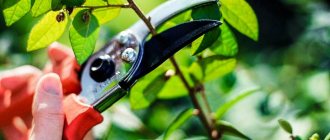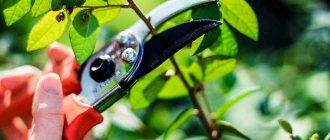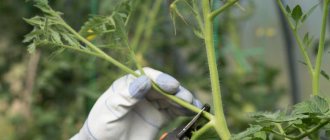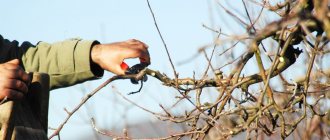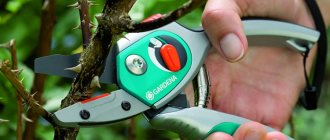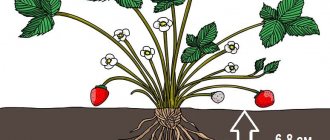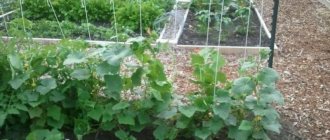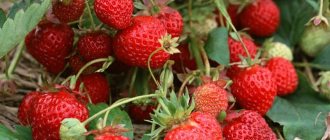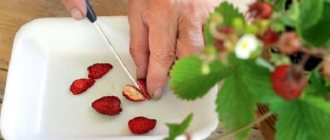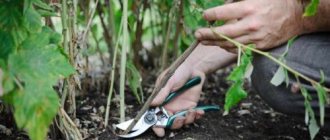Fruits and berries » Strawberries
0
491
Article rating
Kira Stoletova
Pruning strawberries in the fall is an important stage of care that helps rejuvenate the crop, protect it from disease and prepare it for winter. The autumn procedure has advantages and disadvantages that a novice gardener needs to know. In addition, there is an alternative: cutting can be done in early spring or summer, after fruiting.
Autumn pruning of strawberries - diagrams and recommendations
Trim time
In which month it is better to carry out the procedure - everyone decides for himself. Gardeners have differing opinions on this issue.
The haircut can be done in early spring, summer (after fruiting ends) or early autumn (in September). Each of the three options has advantages and disadvantages.
Spring
During cold and little snowy winters, strawberries often freeze, so in the spring, spoiled, frozen and rotten foliage needs to be cut off. In this case, under no circumstances should healthy leaves be touched.
The procedure helps get rid of pests and does not reduce yield (since the plant begins to lay buds in the fall). But if you limit yourself to only spring pruning, the leaves that have aged over time and grown mustache will thicken the plantings (with all the ensuing consequences).
Summer
In summer, the foliage and mustache are cut after the berries have left. Thus, until the end of the season, the beds will not attract pests, but at the same time they will have time to stock up on the necessary substances and form young leaves and flower buds.
The downside of this method: usually at this time gardeners have a lot of other worries and cutting strawberries is simply put off until the fall.
Autumn
This method is practiced during cold winters (in the regions of the Moscow region, the Urals, and the North-West) in order to improve the winter hardiness of plants - to provide the roots with a supply of nutrients.
In addition, many pests strive to overwinter on the leaves of garden strawberries, and autumn pruning deprives them of this opportunity.
The disadvantage of this procedure is the slow growth of green mass in spring and, as a consequence, the later appearance of berries.
Video about the rules, features and procedure for spring pruning of strawberries
When and how to prune strawberry bushes in spring. Detailed description of the cutting process. How not to harm the future harvest. Join the viewing!
Based on the above, it becomes clear that the best time for pruning strawberries is the end of summer after harvest, after which the plants have time to gain strength before frost. But if necessary, this procedure can be carried out in early spring or autumn - during September and early October. The main thing is to carry out pruning according to all the rules, so as not to damage the bushes themselves.
Trimming technology
Green leaves and buds cannot be trimmed
If you choose autumn to prune strawberries, it is extremely important to leave the green leaves and buds intact.
Only damaged, old and dry foliage must be removed (a diseased leaf is easy to identify by color - it becomes yellowish, brown or brown). In addition, the procedure should include trimming the mustaches, since they take a lot of nutrients from the bushes and thicken the beds.
Errors:
- You cannot cut the entire rosette down to the base - you only need to trim the leaf blade without touching the stems.
- It is forbidden to tear off leaves, flower stalks and tendrils with your hands - they are firmly attached, so there is always a risk of pulling out the bush with its roots.
For cutting, you need to take a convenient pruner or garden shears. The tool must be clean and well sharpened.
For greater benefit, when pruning, pull out weeds, loosen the rows and hill up the bushes as necessary.
Do I need to prune strawberries in the fall?
There is no consensus regarding the need for autumn pruning. Some gardeners believe that interfering with the natural cycle will harm the plant, others argue that a little stress will not harm the bushes, but on the contrary will increase productivity.
It is important to consider that for good yields, the bushes should be properly prepared for wintering. They should be fully formed, with healthy, regrown leaves.
Pruning is usually carried out until the end of July, maximum until mid-August. If it is carried out later, the kidneys may not have time to develop. Only the plates of old leaves are removed, leaving the stems intact. This is done with small pruners or sharp scissors. All mustaches are also removed, the soil is cultivated, and the bushes are hilled. After this, the plants are thoroughly watered, sprinkled with ash and mulched.
Renewed bushes with strong foliage will easily endure the winter. In the spring, it will be necessary to remove only the leaves damaged by wintering.
Do remontant varieties need to be pruned?
Remontant strawberries are distinguished from regular ones by the timing of fruiting. It produces a harvest twice a season, and some varieties last the whole summer. Therefore, a radical haircut is not carried out for this crop.
Nevertheless, plantings also need thinning, rejuvenation and preventive procedures. The bushes are regularly inspected, removing old, diseased or dry leaves as necessary. If you do not plan to propagate remontant strawberries with mustaches, trim them too.
The last flower stalks that will no longer bear fruit must be cut off in the fall. Otherwise, they will take too many nutrients from the plant.
How to deal with a mustache
When pruning foliage, gardeners often think about what to do with the mustache. There is only one rule here - in order for the strawberry harvest to be high, it is necessary to regularly remove the mustache. If gardeners did not remove them during the summer season, then it’s time to do it after harvesting. They cannot be pulled out by hand, just like the foliage, since they are firmly bound by the bushes.
All the mustaches from the bush are collected together and trimmed, leaving a section from the base 10 cm long. When pruning, it is important not to damage the heart, which is located in the center of the bush - it is from this that new leaves and flower stalks will appear in the future.
If there are no plans to create a new strawberry plantation this season, then it is better to remove the mustache completely. Otherwise, the bushes of the crop itself will not be visible behind the new rosettes.
Aftercare
You need to get rid of clipped leaves and tendrils immediately - it would be a mistake to leave the trimmings directly on the garden bed. They need to be carefully raked, taken out and burned.
It is advisable to treat the remaining bushes with Bordeaux mixture or fungicide (even if there are no signs of serious damage, this will be a good disease prevention). The soil between the bushes is loosened and weeded, and the plants themselves are hilled.
In order for garden strawberries to gain strength after cutting, they need to be fed. As a fertilizer, you can use mullein solution, stove ash or water-soluble mineral complexes.
To make the crop survive the winter more easily, the beds must be mulched and covered. Dry pine needles, spruce branches, straw, and peat are suitable for these purposes.
Caring for the plant after pruning
After pruning, you need to continue to care for strawberries.
Autumn care after pruning is extremely important. With its help you can increase frost resistance and productivity. Immediately after removing unnecessary foliage, the bushes are prepared for winter.
The preparation looks like this:
- Remove trimmed foliage from the garden bed.
- Loosen the soil without damaging the roots.
- Remove weeds.
- If autumn is dry, water the beds with warm, settled water; it is enough to water 2-3 times within two weeks.
- Irrigate the rows with a weak solution of potassium permanganate, a 1% solution of Bordeaux mixture or any fungicide. Preventative treatment is needed even if there are no signs of disease, since fungal spores may be in the soil.
- To fertilize the plants, you can add organic matter (rotted manure, chicken droppings, mullein) or mineral fertilizers (Superphosphate, Nitroammofoska, Ammonium nitrate).
- Mulch the beds with peat and Christmas tree needles. It is better not to use straw, since slugs and other insects can grow in it and fungus can multiply.
When applying fertilizers, you must remember that it is better to underfeed than to overfeed. Excess nitrogen in the soil will lead to a lush growth of greenery and a decrease in fruiting.
Additional Tips
- The timing of autumn haircuts cannot be delayed. It is advisable to carry it out in early September, so that there is as much time as possible before the onset of frost.
- It is better to immediately collect the cut leaves in a special container, without leaving them on the ground. The foliage will not have to be raked later, and there will be no risky “technical waste” left in the garden that can spread diseases and attract pests.
- If the bush is completely affected by the disease, it needs to be dug up with roots and burned, and the area should be watered with potassium permanganate or treated with a fungicide.
- It is worth remembering that too many shoots on the bushes reduce the quality of the harvest (the berries become smaller). If more than 8-10 stems have grown, they need to be thinned out.
- To protect plants from early frosts, pruning dates can be postponed to the end of summer (mid-August).
- Some gardeners consider autumn pruning risky, since it is at this time that the buds of future fruits are laid. However, if you cut off not the entire stem, but only the leaf blade, the “growth points” are preserved. The optimal height of cut stems (above the ground) should be at least 10 cm.
- When pruning garden strawberries in the spring, under no circumstances should you cut off fresh leaves. The plant will begin to grow green mass with all its might, but will no longer produce ovaries. Thus, you can be left completely without a harvest.
Do I need to prune strawberries after fruiting?
After fruiting, the plants begin to develop young foliage. Old leaves fade and become unnecessary for the plant - they begin to die (Figure 4).
Note: Some gardeners advise removing them from the garden bed to prevent diseases and pests from infecting the young leaves; others say that cutting off the leaves will weaken the bush.
In this regard, a compromise option is recommended: if the bushes are heavily infected, then it is better to get rid of old leaves, and if the plantings are relatively healthy, leave them in place. This method is good to use if you grow strawberries in large quantities. But if you have two or three beds, then the old leaves can be carefully cut off without touching the new ones. This will prevent the spread of fungal diseases throughout the plantings and you will not have to overuse chemicals.
Figure 4. Pruning strawberries after fruiting
When pruning plants from different years of planting, start with the youngest and alternately move on to the older ones. This is done in order to avoid spreading pest larvae on the instruments.
After cutting, the bushes must be fed so that they have time to grow before the cold weather. You will find more information on caring for strawberries in spring, summer and autumn in the video.
Let's sum it up
You can prune strawberries at different times: autumn, spring or summer. Each method has certain advantages, but is not without disadvantages.
The autumn procedure helps prepare the crop for winter and prevents diseases.
If you adhere to the correct technique (cut off only the old and damaged leaf plate, without affecting the stems and healthy leaves), the yield of the plantings will not suffer, but, on the contrary, will increase. In addition, at the end of August and beginning of September, gardeners are not so busy, which allows them to get serious about strawberries.
Frost protection
One of the most important procedures in the fall is protecting strawberries from freezing. For this purpose, it is necessary to create a reliable shelter from frost and snow. Mulching or agrofibre will help solve the problem.
Mulching
In the second half of August, mulch should be laid.
Suitable for this purpose:
- cut grass, which must first be sorted out, shaken, soaked and dried in the sun;
- needles;
- tree bark crushed into large pieces;
- wood shavings or large sawdust.
It is permissible to use peat, but in small quantities. Otherwise, soil over-oxidation will occur.
Mulching is done like this:
- Water and loosen the strawberry beds.
- Place a layer of mulch about 2 cm deep on the soil around the bushes and between the rows.
Agrofibre
It is better to replant strawberries under agrofibre in the fall. The material will protect the plant from frost in winter, and from harmful vegetation in spring.
Boarding procedure:
- Keep the soil free of weeds.
- Dig it up.
- Loosen it.
- Apply fertilizer.
- Spread agrofibre to suit the size of the bed.
- Make holes in it where the holes will be located.
- Plant strawberry seedlings in a new location.
Features of preparation for winter of different varieties
The rules for preparing strawberries for winter are identical for different varieties of berries. There are only small nuances for the usual and remontant type of plant.
Regular
The berry begins to bear fruit early and finishes yielding by the end of July. Basic procedures for preparing for winter can begin as early as August.
The variety tolerates winter well. Vegetable mulch is suitable as a cover. For example, pine needles. It should be laid out after the start of frost.
Remontantnaya
Remontant varieties of strawberries continue to bloom until the onset of cold weather. It is recommended to start preparing for winter no earlier than September.
This variety should be well saturated with moisture before winter. It is necessary to regularly water in the morning or evening with 5 liters of water per sq.m.
Plants usually do not tolerate winter well. You need to make a good shelter. For this purpose, use a thick layer of straw or dry leaves.
